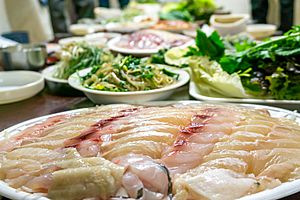Hoe (food) facts for kids
 |
|
| Alternative names | Hwe |
|---|---|
| Type | Raw fish |
| Place of origin | Korea |
| Associated national cuisine | Korean cuisine |
| Variations |
|
| Korean name | |
| Hangul |
회
|
|---|---|
| Hanja |
膾; 鱠
|
| Revised Romanization | hoe |
| McCune–Reischauer | hoe |
| IPA | [ɸwe̞] |
Hoe (pronounced 'hweh') is a popular type of Korean dish made from raw food. It has been enjoyed by Koreans for a very long time, even as far back as the Three Kingdoms of Korea period (57 BC - 668 AD).
Varieties of Hoe
There are two main kinds of hoe: uncooked hoe (회) and blanched sukhoe (숙회). Blanched means the food is quickly dipped in hot water.
Raw Hoe
Raw hoe can be made from fish or meat.
- Saengseon-hoe (생선회) is made from raw fish that has been cut into thin slices.
- Hwareo-hoe (활어회) uses fish that has just been caught and killed.
- Seoneo-hoe (선어회) uses fish that has been aged for a short time, similar to Japanese sashimi.
- Yukhoe (육회) is made from thinly sliced raw meat, often beef.
- Mulhoe (물회) is a cold soup that contains raw fish.
Here are some examples of raw hoe dishes:
- Bangeo-hoe (방어회) – raw amberjack
- Gaebul-hoe (개불회) - raw fat innkeeper worm
- Gul-hoe (굴회) – raw oyster
- Hongeo-hoe (홍어회) – raw skate
- Muneo-hoe (문어회) – raw giant octopus
- Nakji-hoe (낙지회) – raw long arm octopus
- Saengbok-hoe (생복회) – raw abalone
- San-nakji (산낙지) – raw long arm octopus (sometimes still moving!)
Blanched Hoe
Sukhoe (숙회) is a dish where fish, seafood, meat, or vegetables are quickly blanched (dipped in hot water). This makes them slightly cooked but still tender. Ganghoe (강회) is a special type of sukhoe. It uses blanched vegetables like water dropworts and scallions that are rolled up and tied into ribbons.
How Hoe is Prepared
When making hwareo-hoe, the fish is prepared right after it is caught. For seoneo-hoe, the fish is aged for a short time. This means its blood and insides are removed, and it is kept at a special temperature before being sliced. This process makes the fish taste better.
Hoe is often served with tasty dipping sauces. Two common ones are:
- Cho-gochujang: This is a spicy chili paste mixed with vinegar.
- Ssamjang: This is a chili paste mixed with soybean paste.
Many people enjoy eating hoe wrapped in fresh vegetables. These wraps are called ssam. Common vegetables used are lettuce and perilla leaves.
After enjoying hoe at a restaurant, you can often get a spicy fish stew called maeun-tang. This stew is made using the fish bones, head, and any leftover meat from the hoe. It's a great way to finish the meal!
History of Hoe
For a long time in Korea, especially during the Goryeo Dynasty (918–1392), eating fish and meat, including hoe, was not very common. This was because Buddhism, a religion that encourages not harming living things, was very popular.
However, as the influence of Buddhism slowly lessened, people started to eat hoe more often. During the Joseon Dynasty, Confucianism became very important. Since Confucius, a famous philosopher, was known to enjoy eating raw meat, the popularity of hoe grew a lot!
Gallery
-
Bangeo-hoe (raw amberjack)
-
Gaebul-hoe (raw fat innkeeper worm)
-
Godeungeo-hoe (raw chub mackerel)
-
Galchi-hoe (raw largehead hairtail)
-
Muneo-hoe (raw giant octopus)
-
Ojingeo-hoe (raw flying squid)
-
Jeonbok-mulhoe (cold raw abalone soup)
-
Hoe-naengmyeon (cold noodles with hoe)
-
Hoe-deopbap (bibimbap with hoe)
See also
 In Spanish: Hoe para niños
In Spanish: Hoe para niños
















